It looks like you're using an Ad Blocker.
Please white-list or disable AboveTopSecret.com in your ad-blocking tool.
Thank you.
Some features of ATS will be disabled while you continue to use an ad-blocker.
share:
reply to post by filledcup
The change in apparent direction in the comet is due to Hubble's orbit. Hubble only needs to move just over 20,000 km to produce the change in position indicated by the green arrow below:
The up and down motion is only 36% the distance, so Hubble only needs to move back and forth by 7,200 km to produce that change. As my previous animation shows, it clearly does move back and forth that much.
The change in apparent direction in the comet is due to Hubble's orbit. Hubble only needs to move just over 20,000 km to produce the change in position indicated by the green arrow below:
The up and down motion is only 36% the distance, so Hubble only needs to move back and forth by 7,200 km to produce that change. As my previous animation shows, it clearly does move back and forth that much.
Originally posted by ausername
Originally posted by Angelic Resurrection
Regardless of all the explanations given, I smell
something fishy here
You should consider checking the trash bins around you, the dishwasher, and the disposal in the sink.
If you still have a fishy smell, consider calling a professional.
Lol , that's utterly intelligent of you
Another interesting fact about this comet is that it has been recovered 2 weeks early
Could ISON have broken apart when it was between us and the sun?
So the comet is seen 2 weeks early, did it speed up, when/if it broke apart?
CIOC
For several weeks now, ground-based observers have been blind to Comet ISON as our local star was sitting directly between us and the comet. We knew this was a temporary problem, and expected that by the end of August, ground-based observers would begin to detect Comet ISON, so long as it hadn't fizzled out during that time. So now I am delighted to share two pieces of good news: first, that ISON is still alive and well, and secondly that it has been recovered a couple of weeks earlier than I would have expected!
Could ISON have broken apart when it was between us and the sun?
SpaceFellowShip.com
July-August 2013 Sometime in late July or early August, the comet will pass what’s called the frost line, some 230 to 280 million miles away from the sun, when it will feel enough radiation from the sun that water will begin to evaporate and the comet will appear brighter. Some comets have broken up upon crossing the frost line. August-November 2013 Beginning in August, astronomers will be able to observe the comet through ground-based telescopes once again. From early June through late-August, ISON was almost directly behind the sun as viewed from Earth, and thus could not be observed from the ground.
So the comet is seen 2 weeks early, did it speed up, when/if it broke apart?
Originally posted by nataylor
reply to post by filledcup
The change in apparent direction in the comet is due to Hubble's orbit. Hubble only needs to move just over 20,000 km to produce the change in position indicated by the green arrow below:
ok sorry for being a bit slow on this guys. it is the first time im delving this deep into the scientific calculations regarding celestial observations. so just let me make sure i understand..
0.00179 degrees is the distance travelled by hubble's orbit across earth's surface and from our viewpoint.
this movement creates a 0.00064 degree rotation around a moving point(the comet).
and that degree of rotation accounts for an apparent 90 degree turn of the comet from 3 seperate high exposure photographs being stacked on eachother taken at 3 points during a 43 minute period.
this would place the climax of the turn somewhere near 20-25 minute mark(center) within the 43 minute period.
if i understand it all correctly. can i now ask, what is the travel direction of the comet in relation to hubble at that point in time? might be troublesome. i need a sideway solar system view.. a line for the comet's path, the position of earth and hubble at the time of both extremes in the degree of movement 0.00179.
The up and down motion is only 36% the distance, so Hubble only needs to move back and forth by 7,200 km to produce that change. As my previous animation shows, it clearly does move back and forth that much.
how did you come up with these numbers? are u saying the hubble moves back and forth at an interval of 7,200km?
Originally posted by filledcup
that's still more than twice 43 minutes!
First, while the image was exposed for 2,300 seconds, the time between the start of the first exposure and the end of the final exposure is 48 minutes and 27 seconds (there was some down time between exposures). Since you seem to be having trouble visualizing half the ~90-minute orbit I illustrated, let's look at just those 48 minutes.
Left: Hubble's motion over those 48 minutes, as viewed from ISON
Right: ISON's motion over those 48 minutes, as viewed from Hubble:
Each step is 4 minutes.
the one thing youre missing is
if it is a spacecraft, why would it emit SO DAMN MUCH LIGHT ?
its not your regular hi-beams this one.
Maybe its really dark up there and they need to watch out for space-deers and space-mooses
if it is a spacecraft, why would it emit SO DAMN MUCH LIGHT ?
its not your regular hi-beams this one.
Maybe its really dark up there and they need to watch out for space-deers and space-mooses
reply to post by nataylor
And there we go. Problem solved. Matter resolved.
Issue has been de-materialized.
Concirn has become reassurance.
And there we go. Problem solved. Matter resolved.
Issue has been de-materialized.
Concirn has become reassurance.
reply to post by whatnext21
could be a scientific miscalculation on the slingshot effect as it get's pulled around the sun to change course in it's orbit. but yeah.. something happened behind the sun which we couldnt see because we didnt have anything observing from that side. i was earlier going to ask how come we dont have any standing probes in space for that same reason lol
could be a scientific miscalculation on the slingshot effect as it get's pulled around the sun to change course in it's orbit. but yeah.. something happened behind the sun which we couldnt see because we didnt have anything observing from that side. i was earlier going to ask how come we dont have any standing probes in space for that same reason lol
What ever this sighting is we will not know .. they will never show up , and if they do we will not notice that . Because there seems to be an
agreement we don't know about. That's my guess .
Great discovery OP I do believe this could be something important but it will vanish within all other posts like tears in the rain!
Great discovery OP I do believe this could be something important but it will vanish within all other posts like tears in the rain!
edit on
20-8-2013 by 0bserver1 because: (no reason given)
Originally posted by nataylor
Originally posted by filledcup
that's still more than twice 43 minutes!
First, while the image was exposed for 2,300 seconds, the time between the start of the first exposure and the end of the final exposure is 48 minutes and 27 seconds (there was some down time between exposures). Since you seem to be having trouble visualizing half the ~90-minute orbit I illustrated, let's look at just those 48 minutes.
Left: Hubble's motion over those 48 minutes, as viewed from ISON
Right: ISON's motion over those 48 minutes, as viewed from Hubble:
Each step is 4 minutes.
ok for the image on the left.. that's better
so it's as i said right? hubble only covered half the earth's surface in orbit during the 43 minutes. note u have lost the pronounced crescent shape that was being ridden on earlier. but as i said u could draw that green line to create any shape u want. then there is the issue of scale.. that green line cannot be longer than 1/2 the circumference of the earth.
the image on the right which is tracking ISON. is that it's correct placement in relation to earth as hubble observed it?
based on this presentation at wikipedia on ISON..
en.wikipedia.org...
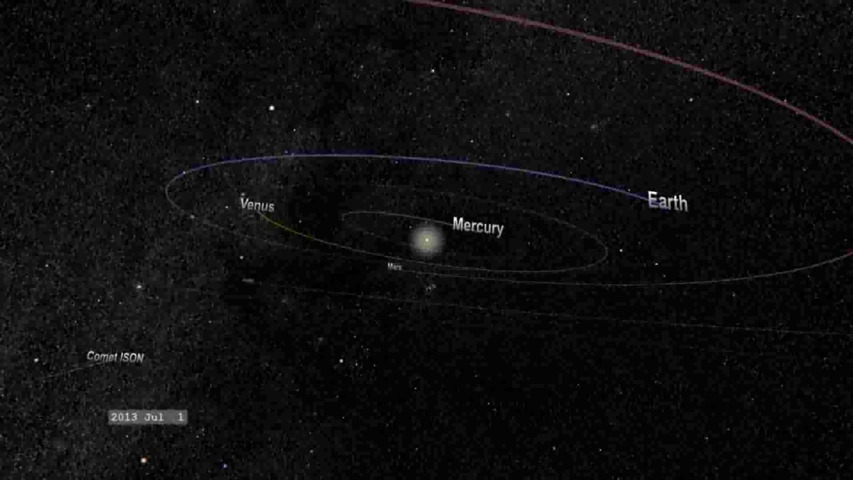
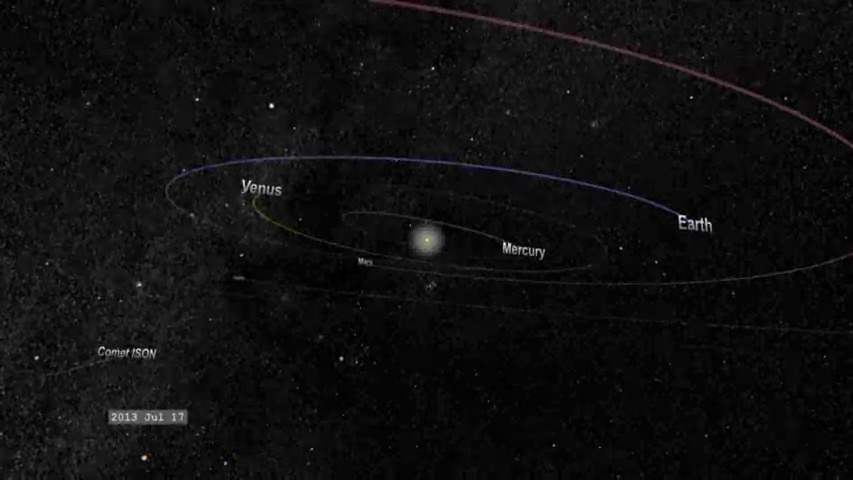
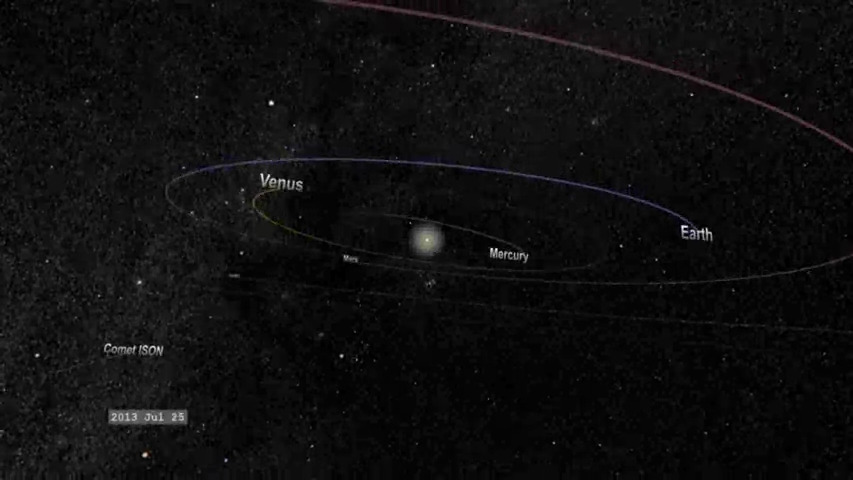
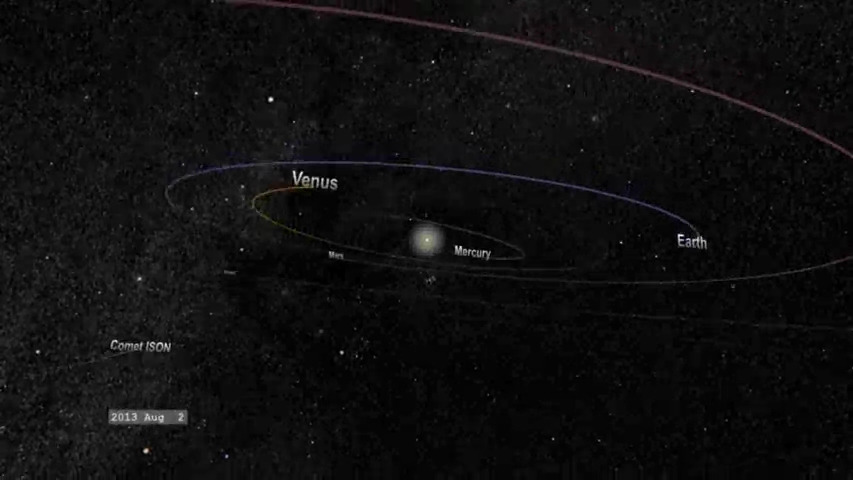
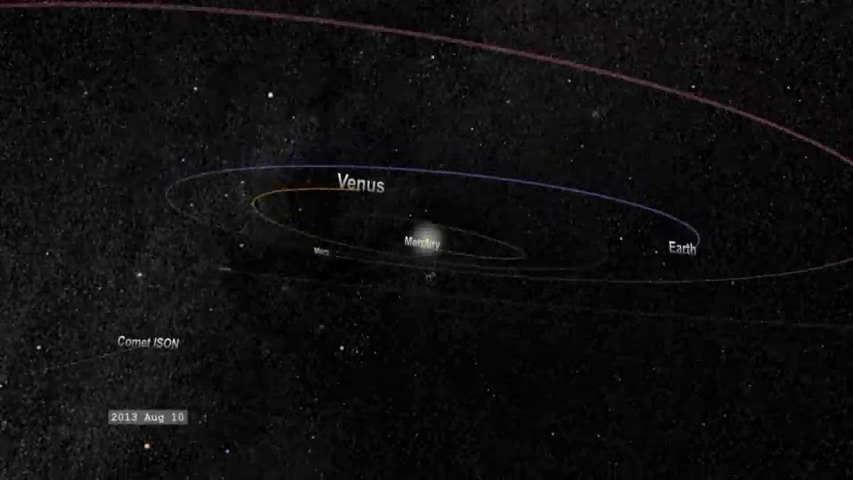
upload.wikimedia.org...
i can see how ISON can appear to change direction in a matter of months. but.. from the viewpoint, the position of the earth and its motion in orbit around the sun.. and the very very tiny angle of difference the hubble makes as it orbits.. i dont see a 90 degree angle appearing in just 43 minutes of exposure. let's round it off to an hour.
is it that we took the shots exactly just before, during and after, as we crossed the 'face' of ISON?
edit on 20-8-2013 by filledcup because: (no reason given)
edit on 20-8-2013 by filledcup because: (no reason
given)
edit on 20-8-2013 by filledcup because: (no reason given)
Originally posted by Thebel
Originally posted by penninja
I have a Theory
Kind of a bit scary and i'm being totally serious.
This is definitely in 3 pieces (Ison), I know my photography, I've read through thread looked at images, been following ison news all along, i'm 100% sure this comet is in three pieces.
I think it's expected to scatter when it rounds the sun. It's going to out gas in different directions and they can't predict exactly where all three pieces are going to go...
I'm thinking it's possible that's what all the hubub is about... the "possibility" of collision, the ammo, the bunkers being built pronto the vanishing money and spending without care....
we "might" be hit by one of the three, they can't accurately predict when it scatters what will happen, only "odds" and very educated guesses so the are scared.
Comet ISON doesn't pose threat to Earth. Its estimated flight path will be over 63 million kilometers away. When Earth passes through ISON orbit, it will be halfway between orbits of Earth and Mars. Those comet pieces are so close to each other that they will interact with each other gravitationally, keeping them close to each other. And if comet really is in 3 parts, it will surely break apart and will not be visible to naked eye when it gets closer to the Sun. Even as whole, it might just break apart to millions of pieces when Sun heats it too much.
Incorrect, the gravitational bonds of objects that size are trivial compared to the outgassing. There is no way to predict where on the bodies they will gas from, you'd have to have the nearly exact composition and distribution of each object, if your dealing with a hard outer shell and water inside you could actually get a "shotgun" effect where they actually explode, a worst case scenario where the slow heating around the sun causes a critical boil from within as it has come around the sun in our direction and we literally receive a spray of many small bodies....
Originally posted by alienDNA
the one thing youre missing is
if it is a spacecraft, why would it emit SO DAMN MUCH LIGHT ?
its not your regular hi-beams this one.
Maybe its really dark up there and they need to watch out for space-deers and space-mooses
Maybe it's the energy given of by their propulsion system
edit on 20/08/2013 by KILLERCODE because: (no reason given)
Originally posted by filledcup
i can see how ISON can appear to change direction in a matter of months. but.. from the viewpoint, the position of the earth and its motion in orbit around the sun.. and the very very tiny angle of difference the hubble makes as it orbits.. i dont see a 90 degree angle appearing in just 43 minutes of exposure. let's round it off to an hour.edit on 20-8-2013 by filledcup because: (no reason given)
The plot on the left side of the animation showing ISON's position over the those 48 minutes perfectly lines up with the path seen in the photo from Hubble:
It's just coincidence that the positions as plotted by my Starry Night Pro software happen to match up exactly, because you have some kind of gut feeling that it wouldn't move like that? I've provided software-plotted diagrams and calculations to back up my position. All you can say is you don't feel like it would move like that. If you can provide calculations or plots from other software that show something different, please do so.
edit on 20-8-2013 by nataylor because: (no reason given)
Originally posted by nataylor
It's orbital velocity is 7.5 km/s. In 2300 seconds, it can travel 17,250 km. The Earth's orbital velocity 29.78 km/s. In 2300 seconds, it can travel 68,494 km. Combining those two, the maximum distance Hubble can travel in 2300 seconds is 85,744 km. That's over 6.5 times the diameter of the Earth itself.
ok maybe my view of orbit is skewed? isnt the 7.5km/sec akin to the travelling velocity of the hubble if earth were at a standstill?
how is it that in 2300s / 38 minutes, hubble can cover 68,494km?
are you then saying that hubble is travelling/orbitting in the same direction as earth's rotation/revolution and that the earth's gravitation as it spins is assisting it in covering more distance in less time than will be represented by actual ground cover?
Originally posted by KILLERCODE
Maybe it's the energy given of by their propulsion systemedit on 20/08/2013 by KILLERCODE because: (no reason given)
no, anti-gravity propulsion only emits light visible for about 1km away.
zeropoint energy propulsion is invisible.
so in case the aliens invented some new kind of propulsion beeing visible several thousands of KMs away, i dont think its an alien spacecract
edit on 20-8-2013 by alienDNA because: (no reason given)
edit on 20-8-2013 by alienDNA because: (no reason given)
reply to post by nataylor
no no the green line i was refering to was for the photograph on the left showing earth. THAT line can be represented in any shape the presenter wants and claim that's how the planet is moving through space.
oh and thanks for telling me the name of the software. ill have a go at it. will go well with stellarium
no no the green line i was refering to was for the photograph on the left showing earth. THAT line can be represented in any shape the presenter wants and claim that's how the planet is moving through space.
oh and thanks for telling me the name of the software. ill have a go at it. will go well with stellarium
edit on 20-8-2013 by filledcup
because: (no reason given)
reply to post by Phantasm
That is exactly what some have been saying this whole thread....
Thanks for the video....
This video explains the ISON image artifact you're discussing here:
(It's explained within the 1st few minutes)
That is exactly what some have been saying this whole thread....
Thanks for the video....
Originally posted by filledcup
reply to post by nataylor
no no the green line i was refering to was for the photograph on the left showing earth. THAT line can be represented in any shape the presenter wants and claim that's how the planet is moving through space.
oh and thanks for telling me the name of the software. ill have a go at it. will go well with stellariumedit on 20-8-2013 by filledcup because: (no reason given)
No the green line on the left won't be represented by any shape you want. That's the path Hubble takes when viewed from comet ISON. The path is as fixed as the green line on the right showing ISON's path is.
dont worry i take full responsibility for being the slow one here. not in anyway trying to say it's a sapce ship that's on it's way to earth as
some are very hopeful of lol. but if it is.. we wont have to wait long to know so not a big deal for me.
it is most likely a comet. im just trying to understand how nasa does it's calculations on observations as it has been a bit mysterious to me for some time and i havent put in the study on the topic required.
i will say however thank you to those who've taken their time and effort to explain it to me. i know i can be a difficult student and ask alot of questions. but i can understand ur frustration. i can take it from here thanks. if i find anything spunky ill let u know
it is most likely a comet. im just trying to understand how nasa does it's calculations on observations as it has been a bit mysterious to me for some time and i havent put in the study on the topic required.
i will say however thank you to those who've taken their time and effort to explain it to me. i know i can be a difficult student and ask alot of questions. but i can understand ur frustration. i can take it from here thanks. if i find anything spunky ill let u know
new topics
-
Why Files Our Alien Overlords | How We Secretly Serve The Tall Whites
Aliens and UFOs: 17 minutes ago -
Curse of King Tuts Tomb Solved
Ancient & Lost Civilizations: 1 hours ago -
What allies does Trump have in the world?
ATS Skunk Works: 1 hours ago -
BIDEN Admin Begins Planning For January 2025 Transition to a New President - Today is 4.26.2024.
2024 Elections: 10 hours ago -
Big Storms
Fragile Earth: 11 hours ago
top topics
-
James O’Keefe: I have evidence that exposes the CIA, and it’s on camera.
Whistle Blowers and Leaked Documents: 17 hours ago, 17 flags -
Australian PM says the quiet part out loud - "free speech is a threat to democratic dicourse"...?!
New World Order: 17 hours ago, 16 flags -
BIDEN Admin Begins Planning For January 2025 Transition to a New President - Today is 4.26.2024.
2024 Elections: 10 hours ago, 9 flags -
Big Storms
Fragile Earth: 11 hours ago, 8 flags -
Shocking Number of Voters are Open to Committing Election Fraud
US Political Madness: 15 hours ago, 7 flags -
Gov Kristi Noem Shot and Killed "Less Than Worthless Dog" and a 'Smelly Goat
2024 Elections: 16 hours ago, 6 flags -
Where should Trump hold his next rally
2024 Elections: 14 hours ago, 5 flags -
Falkville Robot-Man
Aliens and UFOs: 16 hours ago, 4 flags -
Curse of King Tuts Tomb Solved
Ancient & Lost Civilizations: 1 hours ago, 4 flags -
What allies does Trump have in the world?
ATS Skunk Works: 1 hours ago, 2 flags
active topics
-
Falkville Robot-Man
Aliens and UFOs • 12 • : BeTheGoddess2 -
Gaza Terrorists Attack US Humanitarian Pier During Construction
Middle East Issues • 97 • : KrustyKrab -
What allies does Trump have in the world?
ATS Skunk Works • 3 • : sine.nomine -
Why Files Our Alien Overlords | How We Secretly Serve The Tall Whites
Aliens and UFOs • 0 • : 727Sky -
James O’Keefe: I have evidence that exposes the CIA, and it’s on camera.
Whistle Blowers and Leaked Documents • 15 • : Scratchpost -
Starburst galaxy M82 - Webb Vs Hubble
Space Exploration • 12 • : gortex -
Is there a hole at the North Pole?
ATS Skunk Works • 42 • : seekshelter -
Supreme Court Oral Arguments 4.25.2024 - Are PRESIDENTS IMMUNE From Later Being Prosecuted.
Above Politics • 101 • : network dude -
"We're All Hamas" Heard at Columbia University Protests
Social Issues and Civil Unrest • 299 • : KrustyKrab -
Archiving selected UFO threads from ATS as PDF files
Aliens and UFOs • 42 • : burritocat



